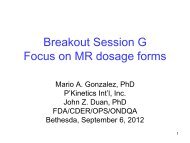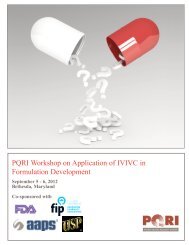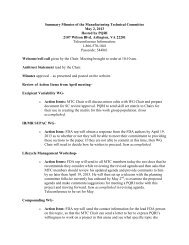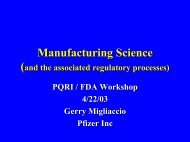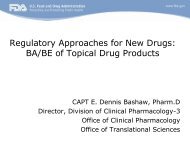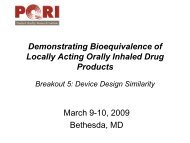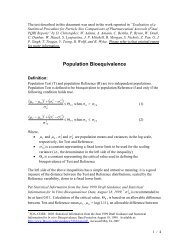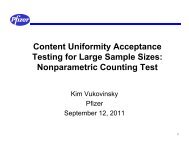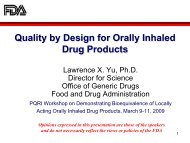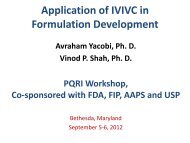September 2002 Newsletter (PDF) - PQRI
September 2002 Newsletter (PDF) - PQRI
September 2002 Newsletter (PDF) - PQRI
Create successful ePaper yourself
Turn your PDF publications into a flip-book with our unique Google optimized e-Paper software.
NEWSNo. 2 - SEPTEMBER <strong>2002</strong>CONTENTS• Welcome • Drug Substance Technical Committee• Message from the Board • Biopharmaceutics Technical Committee• Message from Ken Heimlich • <strong>PQRI</strong> Contributors• <strong>PQRI</strong> Workshop • Circulation and Contact Information• Drug Product Technical CommitteeSteering Committee Chairman’s WelcomeDear <strong>PQRI</strong> Participants and Supporters:Much has transpired since our first newsletter was published. On the personnel front we have hadseveral key changes. Bill Bradley (CHPA) has decided to hang it up and spend his children’sinheritance. He retired from CHPA in June and leaves big shoes to fill. Bill was the CHPArepresentative to the organizing committee when <strong>PQRI</strong> was first conceived, served as the CHPArepresentative to the Steering Committee, and was a member of the Board of Directors since 1999. Hewas also the Treasurer of the Board. We thank Bill for his selfless contributions to the Institute and wishhim a long and healthy retirement. Ed Fry of PDA has been chosen to replace Bill as one of the twoSteering Committee representatives to the Board. Bill Soller is currently representing CHPA on theSteering Committee.John B. "Jack" Cox recently retired as executive director of the AAPS. AAPS, under Jack’s leadership,became a founding member of <strong>PQRI</strong>. During the past several years, Jack has devoted substantial timeand effort to <strong>PQRI</strong> activities. We are grateful for his support and wish him only the best as he begins hisretirement. We also welcome Maureen Downs, acting executive director of AAPS, who has agreed tofulfill Jack's <strong>PQRI</strong> duties.Ken Heimlich has stepped down from his position as Board chair, but will remain on the Board as anAAPS representative. Jerry Skelly has replaced Ken as chair. We thank Ken for his contributions aschair over the past three years and wish Jerry good luck in his new position.At the Technical Committee level, we have two new chairs. Leon Shargel of Eon Labs and Andy Dahlemof Lilly will co-Chair the Biopharm Committee. Andy Dahlem of Lilly will co-chair this committee.Merck’s Pat Tway has replaced John DeFoe (retired from Pfizer) as chair of the Drug SubstanceTechnical Committee. Leon and Pat bring many years of industrial experience to their respectivecommittees and will provide much needed leadership. Welcome to both of them.
chemists from FDA, industry and academia) has been well received. Its recommendations, supported bythe Advisory Committee, have been evaluated by CDER, but have already resulted in the withdrawal ofthe controversial draft guidance on “Blend Uniformity Analysis.”FDA’s newly announced “Pharmaceutical cGMPs Initiative” will be a significant undertaking concerningthe regulation of pharmaceutical manufacturing and product quality. This initiative seeks to integratequality systems and risk management approaches into existing programs, and encourages adoption ofmodern and innovative manufacturing technology. This presents <strong>PQRI</strong> with the opportunity to play asignificant role in developing appropriate scientific regulatory standards to assure the continuedproduction of high-quality pharmaceuticals.To do this however, necessitates the collection and distribution of funds required to finance suchundertakings. The fiscal soundness of the Institute in carrying out its mission must be borne by theindustry. Without their vital financial support, the significant benefits envisioned by this collaborativeeffort will not be realized. It is imperative, if we are to assure the science base of the regulatory process,that industry (innovative and generic) shoulder the cost. While members of the Board presently aresoliciting corporate financial support, those corporations wishing to support the mission of the Institute inadvance of such contact may do so by contacting:Sylvia GanttJerome P. Skelly, Ph.D.Executive Secretary, <strong>PQRI</strong> or Chair, Board of Directors(703) 248-4719 (703) 360-8418Jerome P. Skelly, Ph.D.ChairBoard of Directors, <strong>PQRI</strong>___________________________________Thank you to those retiring.On behalf of the Board of Directors, I want to express the Institute’s gratitude for the seminalcontributions of Dr. Kenneth Heimlich, William Bradley and Jack Cox. Ken, as required by theInstitute’s Bylaws (limiting the chair to a two-year term), retired this spring as the Chair of the Institute’sBoard of Directors. Fortunately for the Institute, he will remain on the Board as a Director. Bill havingretired from the Consumer Healthcare Products Association has not only left his positions as a member ofthe Board and Treasurer of the Institute, but his position on the Steering Committee as well. Jack Coxrecently retired as executive director of the American Association of Pharmaceutical Scientists (AAPS),and has, therefore, also retired from <strong>PQRI</strong> activities. As a founding member of <strong>PQRI</strong>, Jack workedtirelessly in the start up phases of <strong>PQRI</strong> and continued to do so through to his recent retirement. Wewould like to thank him for his many years of dedicated service to the Institute, and wish him best of luckin all of his future endeavors. His presence and counsel will be missed at <strong>PQRI</strong>. These three men heldsignificant leadership positions at a critical juncture for the Institute. Their diligent efforts have seen usthrough the formative years, and we owe them our sincerest appreciation.Jerome P. Skelly, Ph.D.ChairBoard of Directors, <strong>PQRI</strong><strong>PQRI</strong> NEWS No.2 <strong>September</strong> <strong>2002</strong>Page 3
Message from Kenneth R. Heimlich, Outgoing Chairman of the Board of DirectorsAs I pass the chairmanship of the Board of Directors on to Dr. Skelly, I have some thoughts to share. Thepast two years have been challenging as the Board addressed the administrative and fiducial issues facingthe fledgling Institute.While there have been growing pains, the basic concept and mission of <strong>PQRI</strong> have continued to bereinforced. With the science and technology of drug product discovery, development and productionbecoming increasingly complex, the establishment of sound, science-based testing standards and controlswill require increased interface of industry, FDA and academia. The Institute is well structured to providethis strategic forum. It has become ever more apparent that, if <strong>PQRI</strong> did not exist, there would be a rushof action to create it.The success of this critical forum is greatly dependent upon the technical manpower and financial supportof industry. While a number of companies and trade associations have provided funding, others mustlend support in order for the Institute to continue to function. I urge them to do so.I wish to thank the Board members and Sylvia Gantt, <strong>PQRI</strong> Executive Secretary, for their excellentsupport during my term as Chairman, and I extend best wishes to Dr. Skelly as he assumes his duties. Iwill give him my enthusiastic support as a continuing member of the Board.Ken Heimlich, Ph.D.Past ChairBoard of Directors<strong>PQRI</strong> Workshop<strong>PQRI</strong> Workshop Planned for April 3-4, 2003 in Arlington, VAAn open-to-the-public <strong>PQRI</strong> Workshop will be held on April 3-4, 2003 in Arlington, VA. The check-inwill start on Wednesday, April 2, and the Workshop proceedings will take place on Thursday, April 3,and half-day Friday, April 4. A detailed agenda and registration form will be posted on the <strong>PQRI</strong> websiteat http://www.pqri.org.This workshop will feature presentations by the FDA, USP, industry representatives and academia on theprogress of <strong>PQRI</strong> Working Groups, in line with the overall mission of <strong>PQRI</strong> to serve as a forum foracademia, industry and FDA to work cooperatively to conduct pharmaceutical product quality researchand to support development of public standards.Highlights of the meeting include:• AN UPDATE ON <strong>PQRI</strong>’S ROLE IN THE FDA INITIATIVE TO REVISE THE CGMPS• A REPORT ON BLEND UNIFORMITY (AND NEW TECHNOLOGIES) WORKING GROUP AND BLENDUNIFORMITY TRAINING SESSION, presented by Tom Garcia, Ph.D., Pfizer. The session will<strong>PQRI</strong> NEWS No.2 <strong>September</strong> <strong>2002</strong>Page 4
address recommendations from <strong>PQRI</strong> BUWG on sampling for blend uniformity, and their reviewby the FDA. Attendees will learn how stratified sampling may improve the efficiency of thetesting program.• A REPORT ON THE POTENTIAL COST BENEFITS TO INDUSTRY FROM BLEND UNIFORMITYSAMPLING• A REPORT ON HOW TO IMPLEMENT BLEND UNIFORMITY SAMPLINGOther topics to be covered are:DRUG SUBSTANCE TECHNICAL COMMITTEE• REPORT FROM IMPURITIES WORKING GROUP• REPORT FROM PARTICLE SIZE WORKING GROUP• REPORT FROM SPECIFICATIONS WORKING GROUPDRUG PRODUCT TECHNICAL COMMITTEE: PULMONARY GROUPS• REPORT FROM PARTICLE SIZE DISTRIBUTION MASS BALANCE WORKING GROUP• REPORT FROM PARTICLE SIZE DISTRIBUTION PROFILE COMPARISONS WORKING GROUP• REPORT FROM LEACHABLES AND EXTRACTABLES WORKING GROUPDRUG PRODUCT TECHNICAL COMMITTEE (NON-PULMONARY)• REPORT FROM CONTAINER/CLOSURE WORKING GROUP• REPORT FROM BLEND UNIFORMITY (AND NEW TECHNOLOGIES) WORKING GROUP AND BUTRAINING SESSIONBIOPHARMACEUTICS TECHNICAL COMMITTEE• REPORT FROM ORAL IMMEDIATE RELEASE DRUG PRODUCTS WORKING GROUP• REPORT FROM INHALATION AND NASAL DRUG PRODUCTS WORKING GROUP• REPORT FROM TOPIC DERMATOLOGIC DRUG PRODUCTS WORKING GROUPWilliam Stoedter (PDA)Chair, <strong>PQRI</strong> Education Communication and Assessment Subcommittee (ECAS)Look for more information on the <strong>PQRI</strong> website and in the next <strong>PQRI</strong> <strong>Newsletter</strong>.Drug Product Technical Committee (DPTC)DPTCCurrent DPTC members are:Jeffrey Blumenstein (IPAC-RS, Pfizer)Robert Dana (PDA, Elkhorn Associates)Shawn Dressman (USP)Devinder Gill (FDA)Sidney Goldstein, Chair (GPhA, Prasco, LLC)Chris Moreton (IPEC-Americas)Guirag Poochikian (FDA)Richard Poska (PhRMA, Abbott Laboratories)Russell Somma (ISPE, Novartis)Rajendra Uppoor (FDA)<strong>PQRI</strong> NEWS No.2 <strong>September</strong> <strong>2002</strong>Page 5
The following are the DPTC members who are the liaisons to the DPTC working groups:Richard PoskaShawn DressmanChris MoretonJeffrey Blumenstein &Guirag PoochikianBlend Uniformity Working GroupBlend Uniformity Working GroupContainer/Closure Systems Working GroupLeachables & Extractables Working GroupPSD Profile Comparison Working GroupPSD Mass Balance Working GroupBlend Uniformity Working Group (BUWG)Tom Garcia, Ph.D., BUWG Chair (Pfizer – PhRMA)On March 28, <strong>2002</strong>, <strong>PQRI</strong> forwarded to the FDA the Blend Uniformity Working Group’srecommendation “The Use of Stratified Sampling of Blend and Dosage Units to Demonstrate Adequacyof Mix for Powder Blends” and a report summarizing the results obtained from a data mining exercise(“Results of Statistical Analysis of Blend and Dosage Unit Content Uniformity Data Obtained from theProduct Quality Research Institute Blend Uniformity Working Group Data-Mining Effort”). A pressrelease announcing this was issued on April 5, <strong>2002</strong> to various wires and publications for notification ofthe public-at-large. The notification was forwarded to the AAPS press list of about 350 recipients, as wellas the PR Newswire, which accesses more than 2,400 newspapers, wire services, and broadcast pointsacross the United States. Both documents have been posted on the <strong>PQRI</strong> website. On May 17, <strong>2002</strong>, theFederal Register reported that the FDA withdrew the draft guidance document entitled, “ANDAs: BlendUniformity Analysis” originally issued August 3, 1999.The Blend Uniformity Working Group’s recommendation and results of the data mining exercise werepresented and discussed at the May 8, <strong>2002</strong> ACPS meeting, where the panel endorsed it. Transcripts ofthis meeting are available at: http://www.fda.gov/ohrms/dockets/ac/02/transcripts/3860T2.pdfUpon the completion of their review of the recommendation and data mining report, FDA/CDER issued aresponse to <strong>PQRI</strong> on August 14, <strong>2002</strong>. <strong>PQRI</strong> members will meet with the CDER reviewers on October17, <strong>2002</strong> to address the concerns raised in this response.Members of the Blend Uniformity Working Group are:Garth Boehm (Purepac, GPhA)John Dietrick (FDA)Muralidhara Gavini (FDA)Jean-Marie Geoffroy (Abbott, PhRMA)Pedro Jimenez (Lilly, PhRMA)James Prescott (Jenike and Johanson, GPhA))Fernando Muzzio (Rutgers University, AAPS)Jozef Timmermans (Pfizer, PhRMA)Jon Clark (FDA)Thomas Garcia, Chair (Pfizer, PhRMA)Loren Gelber (Andrx, GPhA)Jack Hoblitzell (Teva, GPhA))Jerry Planchard (Aventis, PhRMA)Gerald Mergen (McNeil)Neeru Takiar (FDA)Particle Size Distribution (PSD) Mass Balance Working GroupTerry Tougas, Ph.D., Chair (Boehringer Ingelheim, IPAC-RS)The Work Plan of the <strong>PQRI</strong> PSD Mass Balance Working Group has been approved by the DPTC andSteering Committee. It can be viewed at http://www.pqri.org/minutes/pdfs/dptc/psdmbwg/workplan02.pdf.In accordance with the Work Plan, the Mass Balance WG is developing the following documents:<strong>PQRI</strong> NEWS No.2 <strong>September</strong> <strong>2002</strong>Page 6
• A data reporting form (template spreadsheet with instructions) and accompanying request-letter forthe eventual PSD data-mining survey. It is expected that both industry and Agency data will begathered in the survey.• A document entitled “Considerations for the Development and Practice of Cascade Impaction TestingIncluding a Mass Balance Failure Investigation Tree”. The document will serve to concentrate adviceon “good cascade impactor practices” and will help define the role of the mass balance test in anoverall quality control program.• A protocol of the planned experiment designed to investigate the cascade impaction methodvariability.All of the above-mentioned drafts were discussed and revised by the full Working Group during a twodayface-to-face meeting on <strong>September</strong> 24-25, in Rockville, MD. For further details, see the minutes ofthis WG at http://www.pqri.org/minutes/dptc.htm.Current members of the Mass Balance Working Group are:Dave Christopher (Schering-Plough, IPAC-RS)Myron Diener (Aventis, PhRMA)Kenneth Furnkrantz (FDA)Karl Lin (FDA)Brian Rogers (FDA)Terrence Tougas, Chair (Boehringer Ingelheim, IPAC-RS))Bruce Wyka (Schering Plough, IPAC-RS)Paul Curry (Boehringer Ingelheim, USP)Bill Doub (FDA)Martin Lavery (Aventis, IPAC-RS)Jolyon Mitchell (Trudell Medical International, AAPS)Helen Strickland (GlaxoSmithKline, PhRMA)Yi Tsong (FDA)PSD Profile Comparisons Working GroupDavid Christopher, Chair (Schering-Plough, IPAC-RS)This Working Group’s Work Plan was considered by the DPTC and SC, and approved on 15 and 29August, respectively. The first phase of the work relies heavily on simulations, which are based on realworlddata. The simulations are needed to investigate the robustness of the chi-square profilecomparisons method developed by the Agency. The WG statisticians are applying the method to various“null” distributions and examining its results in a range of “what-if” scenarios. The insights gained inthese explorations will be discussed by the full WG during a meeting in Washington, DC on October 30,<strong>2002</strong>. In the meantime, the Group is also discussing relevant practical details of cascade impaction testsfor the purpose of bioequivalence PSD profile comparisons. In addition, the WG is collaborating with the<strong>PQRI</strong> PSD Mass Balance WG in the experiment which will investigate the method variability associatedwith the cascade impaction test.For further details, see the minutes of this WG at http://www.pqri.org/minutes/dptc.htm and the WorkingGroup’s Work Plan at http://www.pqri.org/minutes/pdfs/dptc/psdpcwg/workplan02.pdf.Current members of the Profile Comparisons Working Group are:Wallace Adams (FDA)Douglas Lee (Pfizer, PhRMA)Craig Bertha (FDA)Jolyon Mitchell (Trudell Medical International, AAPS)Peter Byron (Virginia Commonwealth University, USP) Gur Singh (FDA)David Christopher, Chair (Schering-Plough, IPAC-RS) Terrence Tougas (Boehringer Ingelheim, IPAC-RS)Bill Doub (FDA)Yi Tsong (FDA)Lester Harrison (3M Pharmaceuticals, AAPS)Ronald Wolff (Eli Lilly, PhRMA)Walter Hauck (Thomas Jefferson University, AAPS) Bruce Wyka (Schering-Plough, IPAC-RS)<strong>PQRI</strong> NEWS No.2 <strong>September</strong> <strong>2002</strong>Page 7
Leachables and Extractables Working GroupDaniel Norwood, Ph.D., Chair (Boehringer Ingelheim, IPAC-RS)During the next several months, the Leachables and Extractables Working Group plans to performextraction studies on rubber and plastic test articles, which will provide data that can be used towardaddressing thresholds. To this end, the Working Group is developing experimental protocols for the testarticles. Working Group members have supplied several batches of the test articles, and severallaboratories have offered their services for performing the experiments. It is expected that laboratorieswill be selected in early fall <strong>2002</strong>.The Working Group is also developing a justification for a qualification threshold. The justification willinclude among other things, an analyses of information from toxicological databases, information fromambient air studies, and consideration of existing guidelines.The full Working Group will hold a face-to-face meeting on October 24, in Washington, DC, to discussits documents and experimental work, and agree on next steps.Current members of the Leachables and Extractables Working Group are:Douglas Ball (Pfizer, IPAC-RS)Frances DeGrazio (West Pharmaceuticals, PDA)Gordon Hansen (Boehringer Ingelheim, IPAC-RS)Timothy McGovern (FDA)Daniel Norwood, Chair (Boehringer Ingelheim, IPAC-RS)Diane Paskiet (Monarch Analytical, PDA)Mark Vogel (Pharmacia, PhRMA)James Blanchard (Aradigm, IPAC-RS)Thomas Feinberg (Magellan Laboratories, AAPS)Roger McClellan (University of New Mexico, AAPS)Roxana Nikoui (Valois America, AAPS)David Porter (USP)Alan Schroeder (FDA)Drug Substance Technical Committee (DSTC)DSTCImpurities Working GroupJohn Carrano, Chair (Wyeth, PhRMA)The Drug Substance Impurities Working Group has recently received the <strong>PQRI</strong> Steering Committee’sapproval for one of its projects, entitled Impurity Characterization and Quantification Questionnaire.The Hypothesis of the Working Group is that more resources are being expended at early stages of drugdevelopment than is required by regulations since there are no clear guidances for the early stages of drugdevelopment. This represents an unnecessary use of resources that could potentially be eliminated. TheQuestionnaire is being used as a tool to determine the current practice used in industry to identify andcharacterize impurities. Once the information from the Questionnaire is obtained, it will be evaluated todetermine if the Hypothesis is true. Assuming it is true, the next step of the Working Group will be todevelop additional Work Plans that will lead to recommendations for reducing the current regulatoryburden.The Questionnaire was distributed at the end of August, with a deadline of <strong>September</strong> 30 set by theWorking Group. An initial compilation of the information will be made in October. The Working Groupwill then meet to analyze the data and make recommendations based on this analysis. The Questionnaire<strong>PQRI</strong> NEWS No.2 <strong>September</strong> <strong>2002</strong>Page 8
esults and the Working Group recommendations will be presented at the <strong>PQRI</strong> meeting scheduled forearly 2003.If you do not receive a survey and would like to participate, please contact Ms. Sylvia Gantt at <strong>PQRI</strong>[GanttS@<strong>PQRI</strong>.org].Current members of the Impurities Working Group are:Christiana Moji Adeyeye (Duquesne University, AAPS)John Carrano, Chair (Wyeth, PhRMA)Henry Drew (FDA)Matthew Gosnell (Alkermes, PhRMA)Anne Maule-Fox (3M Pharmaceuticals, PhRMA)Yafei Zhang (Pfizer, Inc., PhRMA)Bonnie Avery (University of Mississippi, AAPS)Chung-Chow Chan (Eli Lilly and Company, PhRMA)Patrick Faustino (FDA)Zi-Qiang Gu (FDA)Ken Sigvardson (Schering-Plough, PhRMA)Drug Substance Specifications and BACPAC Working GroupAngelos Dovletoglou, Ph.D., Chair (Merck, PhRMA)The Working Group developed the following hypothesis: A core set of specifications (tests, analyticalmethods, and acceptance criteria) together with impurity profile and physical property evaluation areadequate to assure the identity, strength, quality, purity, and potency of a drug substance.The premise of any drug substance specification is that it is either predictive or important for fundamentalcharacteristics including safety, stability and performance. Thus, one needs tests that measure thefundamental parameters which control or at least affect these characteristics. For example, withpolymorphism, the crystallization conditions are key in determining which polymorph is formed. Also,storage conditions (temperature and relative humidity) are known to influence polymorphic stability.These facts are reflected in FDA and ICH stability guidelines, which carefully specify these conditions.Changes in the method of the manufacture of drug substance carries some risk of impacting either thephysical properties of the drug substance or the level or nature of impurities present. It is generallyaccepted that these potential changes are greater when the modification occurs near the end of a drugmanufacturing process rather than the beginning. An evaluation of the impact of a manufacturing changeafter the final intermediate on drug substance quality must include conformance to establishedspecifications, but the evaluation must also be done in the context of knowledge that contributed toestablishing the specifications.The working group is focusing its efforts on preparing recommendations for the agency on the potentialimpact of manufacturing changes (post final intermediate) on API quality with the goal of makingrecommendations on data required to support a given process change and the appropriate filingmechanism. The group will work with the PhRMA subteam that is addressing the same concerns.Current members of the Specifications Working Group are:James Brower (FDA)Angelos Dovletoglou, Chair (Merck, PhRMA)Munir Hussain, Ph.D. (Eli Lilly, PhRMA)Lih-Yang Lin, Ph.D. (ScinoPharm, GPhA)Bernard Olsen, Ph.D. (Eli Lilly, PhRMA)Bill Weiser, Ph.D. (Magellan Labs, AAPS)Hitesh Chokshi, Ph.D. (Hoffmann-LaRoche, PhRMA)Stephen Hoag, Ph.D. (University of Maryland, AAPS)Everett Jefferson (FDA)Jai Mehta (JM Pharma, AAPS)Tom Schultz, Ph.D. (R.W. Johnson, AAPS)<strong>PQRI</strong> NEWS No.2 <strong>September</strong> <strong>2002</strong>Page 9
Particle Size Working Group of DSTCFrank Etzler, Ph.D., Chair (Boehringer Ingelheim, PhRMA)The Particle Size Working Group has surveyed the types of particle sizing equipment used in thepharmaceutical industry and found that a wide variety of instruments are used to characterize particle size.Microscopy (both optical and scanning electron microscopy) and Laser Diffraction (Mie-Fraunhofer) arethe most commonly used methods.A review of the scientific literature indicates that various particle-sizing methods can yield calculatedparticle size distributions, which differ significantly from one another. Laser diffraction methods appearto be particularly prone to instrument-produced artifacts.The Working Group is preparing a document that describes the “best current practices” in particle sizeanalysis. The document will address the capabilities and limitations of the current science andtechnology. It will also identify areas for future work, such as particle-size distribution dependency onthe choice of measuring instrument, instrumental artifacts resulting in incorrectly reported particle-sizedistributions, the need for better calibration and performance verification standards, and the need for abetter understanding of the relationships between particle-size and product performance. This documentwill also address the suitability of the instrumentation and methodology for materials being tested, takinginto account the phase of development and dosage form.The final work product of this group will serve as a reference on particle-size analysis in thepharmaceutical industry, and will be targeted for a USP chapter.Current Members of the Particle Size Working Group are:Jim Allgire (FDA)Rick Bruce (The R.W. Johnson PRI, AAPS)James Drennen (Duquesne University, AAPS)Frank Etzler, Chair (Boehringer-Ingelheim , PhRMA)Ron Mueller (GlaxoSmithKline, PhRMA)Van Reif (Schering-Plough Research Institute, PhRMA)Sharon Snorek (Eli Lilly and Company, PhRMA)Michael VanOort (GlaxoSmithKline, PhRMA)John Bauer (Abbott Laboratories, PhRMA)Nallaperumal Chidambaram (FDA)Eric Duffy (FDA)Ken Morris (Purdue University, AAPS)Hullahalli Parsanna (FDA)Brian Scarlett (Engineering Research Center for ParticleScience, Chairman referral)Pascal Toma (Bristol-Myers Squibb, AAPS)Biopharmaceutics Technical Committee (BTC)BTCLeon Shargel, Ph.D., Chair (Eon Labs, GPhA)Current members of the BTC are:Wallace P. Adams, Ph.D., (FDA)Raman K. Baweja, Ph.D. (FDA)Dale P. Conner, Pharm.D. (FDA)Paul Fackler, Ph.D. (Teva, GPhA)Joel Sequeria, Ph.D. (Schering-Plough, PhRMA)Leon Shargel, Ph.D., Co-Chair (Eon Labs, Inc., GPhA)Gordon Amidon, Ph.D. (University of Michigan, AAPS)Lars Borgström, Ph.D. (AstraZeneca, IPAC-RS)Andrew M. Dahleem, Ph.D., Co-Chair (Eli Lilly, PhRMA)Ronald Manning, Ph.D. (USP)Vinod Shah, Ph.D. (FDA)<strong>PQRI</strong> NEWS No.2 <strong>September</strong> <strong>2002</strong>Page 10
Biopharmaceutics is the study of the interrelationship of the physicochemical properties of the activepharmaceutical ingredient, API and the drug product on the in vivo performance of the drug.Biopharmaceutics also considers the formulation of the drug product including excipients, the method ofmanufacturing, and the route of drug administration. A primary concern in biopharmaceutics is thebioavailability of drugs. Bioavailability (BA) refers to the measurement of the rate and extent of drugthat is absorbed from a drug product and becomes available at the site of action. In addition,bioequivalence (BE) studies are often performed to compare the bioavailability of the same drug fromtwo of more drug products. Thus, BA and BE are used to evaluate or predict the in vivo performance ofdrug products.In terms of regulatory product quality attributes, BA and BE may be viewed as productquality/performance specifications. A specific regulatory challenge is to validate these methods, to assurethat they relate in a well-defined way to safety and efficacy of the active drug substance.MissionThe mission of the BTC is to promote research in the area of biopharmaceutics. Specific research projectsare developed by each of the BTC working groups. Areas of interest include: linkage of in vitro drugdissolution/release methods to in vivo drug bioavailability and bioequivalence, methods for thedetermination of bioavailability and bioequivalence, pharmacokinetic-pharmacodynamic (PK/PD)relationships and comparative clinical trials. The outcome of this research will lead to recommendations,based on scientific evidence, for the development of regulatory policy, changes in regulatory policy orguidances, and in development of public standards.Immediate Release Drug Products Working GroupJames Polli, Ph.D., Chair (University of Maryland, AAPS)BackgroundBioavailability of the drug from immediate release drug products generally depends upon thephysicochemical characteristics of the API and the formulation of the drug product. Drugdissolution/release tests are primarily used as a quality control test to assure batch-to-batch drug releaseuniformity, stability, success of scale-up and post-approval changes (SUPAC), and may predict in vivoperformance.Broadly, the Working Group hopes to elucidate the combination of factors, particularly biopharmaceuticfactors, that would allow estimation of oral absorption from oral dosage forms. The longer-term goal is topredict oral bioavailability, and hence risk of drug product failure, from biopharmaceutic data.MissionThe mission of the Immediate Release Drug Products WG is to expand the application of in vitroapproaches in the documentation of bioavailability and bioequivalence. The working hypothesis is thatfor drugs with specific biopharmaceutical properties, in vivo bioequivalence testing can be waived forimmediate-release solid oral dosage forms that comply with in vitro requirements.In vitro tests may include drug solubility, drug dissolution/release specifications, and drug permeability.The Food and Drug Administration (FDA) has issued a guidance document that outlines aBiopharmaceutics Classification System (BCS) that allows for the waiver of in vivo bioavailability and<strong>PQRI</strong> NEWS No.2 <strong>September</strong> <strong>2002</strong>Page 11
ioequivalence studies under certain conditions for immediate-release oral solid dosage forms. Since theissuance of the BCS guidance, industry and regulators have gained more experience with the issue.Additional, developments in biopharmaceutics have continued that may extend the BCS guidance. TheBCS guidance naturally undergoes continuous review from the scientific community, in agreement withFDA practice of “good guidance.”ActivitiesThe WG has developed several research proposals and surveys to predict in vivo drug performance usingin vitro testing. The projects include:1. Influence of Common Excipients on Drug Intestinal Permeability2. Influence of Common Excipients on Intestinal Transit and Absorption of Class 3 Drugs3. Criteria for Dissolution Profile Similarity for Class 1 and Class 3 DrugsThese three research proposals involve the effect of excipient on drug intestinal permeability, excipienteffect on intestinal transit, and the evaluation of methods to compare dissolution profiles. The first twoproposals are motivated by the possibility of allowing BCS-based “biowaivers” to include Class 3 drugs.These projects will assess whether excipients modulate drug permeability and intestinal transit, and hencemodulate bioavailability/bioequivalence, while perhaps other tests would overlook these possible effects.The third project primarily aims to identify, through analysis of available real data sets of Class 1 drugs,acceptance criteria for dissolution profile comparison (e.g., f2 criteria) that may be less stringent than thecurrent standard, yet assure ongoing bioequivalence.In addition, the Working Group is planning the following surveys: Survey of Oral Ionizable Drugs andSurvey of Bioinequivalence Risk of Class 3 Drugs.The members of the Working Group on Oral Biopharmaceutics of Immediate Release Products (OBIRP)are:Philip S. Burton, Ph.D. (Pharmacia, AAPS)Sanjeev Kaul, Ph.D. (Bristol-Myers Squibb, PhRMA)Michael B. Maurin, Ph.D. (QS Pharma)James E. Polli, Chair (University of Maryland)Lawrence Yu (FDA)Kuldeep Dharival, Ph.D. (FDA)S.W. Johnny Lau, Ph.D. (FDA)Armen P. Melikian (Drug Development Resources)Dilip R. Sanvordeker (Watson Pharmaceuticals)Ian R. Wilding (Pharmaceutical Profiles)Inhalation And Nasal Drug Products Working Group of BTCBackgroundOrally inhaled and nasal drug products (OINDP) are important for the treatment of an increasing numberof diseases. Many of the drug products are marketed as drug-device combinations that enable the drug tobe delivered directly to sites in the lungs or nose. These drugs are intended for local or systemictherapeutic activity. The drug-device combination may introduce complexity in drug delivery to thepatient and assessment of the performance or relative performance of the product. Issues of concern withOINDP include dose-response estimation, the relationship of in vitro drug performance to in vivo drugdelivery, measurement of bioavailability and establishment of bioequivalence.<strong>PQRI</strong> NEWS No.2 <strong>September</strong> <strong>2002</strong>Page 12
MissionThe mission of this working group is to promote regulatory research in the area of OINDP to supportFDA policies and guidances for in vitro and in vivo bioavailability and bioequivalence, with emphasis onlocally acting drugs. The WG will evaluate, develop and oversee the conduct of research projectsproposed by FDA, academia or industry. Projects may focus on PK/PD relationships for locally actingOINDP, in vitro-in vivo correlations (IVIVC) for locally acting nasal sprays, and other issues.ActivitiesA current project under consideration is an exploratory dose-response study for inhaled corticosteroids.The results of this project are intended to develop a pharmacodynamic or clinical design that is sensitiveto potential dose differences between products. These results may help in designing studies that willevaluate the relative performance of these products, including bioequivalence studies for ANDA/NDAsubmissions and post-approval changes.Wallace P. Adams, Ph.D. (FDA)<strong>PQRI</strong> Biopharmaceutics Technical Committee is seeking members for this Working Group.If you have an interest in participating in the work of <strong>PQRI</strong> and have experience in inhalation or nasaldrug products, please submit your name and electronic resume or CV to Sylvia Gantt at gantts@pqri.org.Questions may be directed to the <strong>PQRI</strong> office at 703-248-4719, or to the e-mail address above.Topical Drug Products Working GroupBackgroundTopical dermatological drug products are designed to deliver drugs to the skin to prevent or treat adisease. Presently, there are no general approaches that objectively measure the bioequivalence of thesedrug products. Clinical studies have been performed for some dermatologic drug products such asantifungals, antibiotics and anti-acne products. Clinical studies are costly and can be highly variable.Dose response effects are difficult to quantitate using clinical endpoints. For some specific drugs such asthe topical glucocorticoids, a comparative clinical trial or skin blanching procedure has been used for thedetermination of bioequivalence.MissionTo develop science based in vivo and/or in vitro methods as an alternative to a comparative clinical trial,to demonstrate bioequivalence of topical dermatological drug products. The development of validated invitro drug release methods are also important as a quality control tool to assure batch-to-batchconsistency. Some methods that have been studied include skin permeation studies using diffusion cellsand skin stripping studies. Other approaches may also be considered. These studies will aid in thedevelopment of a topical dermatological drug products policy and/or guidance.Avi Yacobi, Ph.D. (Taro Pharmaceuticals)Vinod P. Shah, Ph.D. (FDA)<strong>PQRI</strong> Biopharmaceutics Technical Committee is seeking members for this Working Group.If you have an interest in participating in the work of <strong>PQRI</strong> and have experience in topical drug products,please submit your name and electronic resume or CV to Sylvia Gantt at gantts@pqri.org. Questions maybe directed to the <strong>PQRI</strong> office at 703-248-4719, or to the e-mail address above.<strong>PQRI</strong> NEWS No.2 <strong>September</strong> <strong>2002</strong>Page 13
<strong>PQRI</strong> ContributorsThe Product Quality Research Institute (<strong>PQRI</strong>) gratefully acknowledges the following companies andorganizations for their financial support:Eli Lilly & CompanyAventis PharmaceuticalsDuPont Pharmaceuticals CompanyMerck & CompanyNovartis Pharmaceuticals CorporationPenwest Pharmaceuticals CompanyPowrex CorporationAmerican Association of Pharmaceutical Scientists (AAPS)Consumer Healthcare Products Association (CHPA)Generic Pharmaceutical Association (GPhA)International Pharmaceutical Aerosol Consortium on Regulation and Science (IPAC-RS)International Pharmaceutical Excipients Council of the Americas (IPEC- Americas)International Society for Pharmaceutical Engineering (ISPE)Parenteral Drug Association (PDA)Pharmaceutical Research and Manufacturers of America (PhRMA)United States Pharmacopeia (USP)Circulation and Contact Information<strong>PQRI</strong> News is available free of charge to all <strong>PQRI</strong> participants and sponsors. It is available to the generalpublic through the <strong>PQRI</strong> website (www.pqri.org). If you (or somebody you know) wish to receive thisnewsletter automatically via email, please provide relevant email addresses to Sylvia Gantt at the addressbelow.Please feel free to contact <strong>PQRI</strong> if you have any questions, requests or comments.Sylvia J. Gantt<strong>PQRI</strong> Executive Secretary2107 Wilson Boulevard - Suite 700Arlington, VA 22201Phone 703.248.4719 -- Fax 703.525.7136GanttS@pqri.orgFor more information about <strong>PQRI</strong> please visit:http://www.pqri.org<strong>PQRI</strong> NEWS No.2 <strong>September</strong> <strong>2002</strong>Page 14



